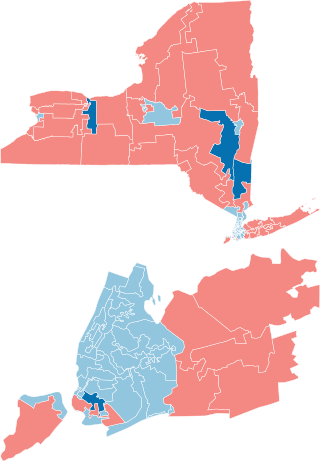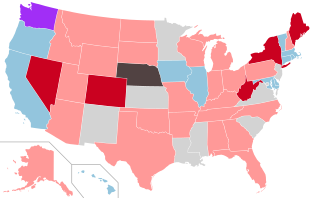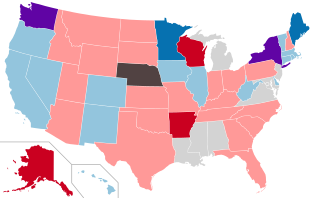The Democratic Senatorial Campaign Committee (DSCC) is the Democratic Hill committee for the United States Senate. It is the only organization solely dedicated to electing Democrats to the United States Senate. The DSCC's current Chair is Senator Gary Peters of Michigan, who succeeded Nevada's Catherine Cortez Masto after the 2020 Senate elections. DSCC's current executive director is Christie Roberts.
New York is a Democratic stronghold and is considered one of the "Big Three" Democratic strongholds alongside California and Illinois. The following table indicates the party of elected officials in the U.S. state of New York:

The New York State Senate is the upper house of the New York State Legislature, while the New York State Assembly is its lower house. Established in 1777 by the Constitution of New York, its members are elected to two-year terms with no term limits. There are 63 seats in the Senate. The Democratic Party has held control of the New York State Senate since 2019. The Senate Majority Leader is Andrea Stewart-Cousins.

Simcha Felder is an American politician from Borough Park, Brooklyn. He represents the 22nd district of the New York State Senate. Felder has been elected to multiple offices as a Democrat, but is known for having caucused with the Republicans during the early part of his New York State Senate tenure. Prior to serving in the State Senate, Felder represented the 44th district in the New York City Council.

José Rafael Peralta was an American politician who served in the New York State Assembly and New York State Senate. A member of the Democratic Party, he last represented District 13 in the State Senate, which includes the Queens neighborhoods of Corona, East Elmhurst, Elmhurst, Jackson Heights, and Woodside. He previously represented District 39 in the New York State Assembly, which is located in Queens, New York and includes Corona, Elmhurst and Jackson Heights. He was elected to the New York State Senate in a landslide on March 16, 2010. Peralta was a member of the Independent Democratic Conference (IDC), a group of Democratic senators who allied themselves with Senate Republicans. He was re-elected in 2012, 2014 and 2016, but was defeated in the 2018 Democratic primary.

The 2012 New York state elections took place on November 6, 2012. These elections included the 2012 presidential election, an election to one U.S. Senate seat, and elections to all 27 New York congressional seats, all 63 seats in the New York State Senate, and all 150 seats in the New York State Assembly.
The Majority Coalition Caucus (MCC) was a caucus formed on December 10, 2012, by all 23 Republican members of the Washington State Senate and two Democratic senators. Its membership constituted a majority of the chamber's 49 members, allowing it to take control of the Senate from the Democratic caucus whose members had previously formed a majority. The MCC, operating much like a coalition government, offered an equal number of committee leadership positions to Republicans and Democrats. Senate Democrats accepted only three of the nine positions offered them. The Republicans strengthened their position by gaining one seat in the 2013 election, but lost its majority following a special election in November 2017. The coalition has 23 Republicans and one self-identified Democratic senator, Tim Sheldon. On November 15, 2017, the Majority Coalition Caucus returned to being the state Senate Republican Caucus.

The 2016 United States elections were held on Tuesday, November 8, 2016. Republican nominee Donald Trump defeated Democratic former Secretary of State Hillary Clinton in the presidential election, while Republicans retained control of Congress. This marked the first and most recent time Republicans won or held unified control of the presidency and Congress since 2004.

The 2012 New York State Senate elections were held on November 6, 2012 to elect representatives from all 63 State Senate districts in the U.S. state of New York. Primary elections were held on September 13, 2012.

The Independent Democratic Conference (IDC) was a group of several Democratic members of the New York State Senate that was formed to caucus with the Republican Party and protect its status as the majority party. At the time of its dissolution, the IDC included eight members: Jeffrey D. Klein, Marisol Alcantara, Tony Avella, David Carlucci, Jesse Hamilton, Jose Peralta, Diane Savino, and David Valesky.

The 2016 New York state elections took place on November 8, 2016. Presidential primary elections occurred on April 19, 2016, congressional primary elections occurred on June 28, 2016, and state and local primary elections occurred on September 13, 2016. One U.S. Senate seat and all 27 seats in the U.S. House of Representatives were up for election, as were all 63 seats in the New York State Senate and all 150 seats in the New York State Assembly. The 2016 United States presidential election occurred on the same date as the general election.

The 202nd New York State Legislature, consisting of the New York State Senate and the New York State Assembly, met from January 4, 2017, to December 31, 2018, during the seventh and eighth years of Andrew Cuomo's governorship, in Albany

The 2018 Colorado State Senate elections took place as part of the biennial United States elections. Colorado voters elected state senators in 17 of the 35 districts in the state senate. State senators serve four-year terms in the Colorado State Senate. The Colorado Reapportionment Commission provides a statewide map of the state Senate here, and individual district maps are available from the U.S. Census here.

The 2018 Nevada Senate election took place as part of the biennial United States elections. Nevada voters elected state senators in 11 of the state senate's 21 districts. State senators serve four-year terms in the Nevada State Senate.

The 2018 New York State Senate elections were held on November 6, 2018, to elect representatives from all 63 State Senate districts in the U.S. state of New York. Primary elections were held on September 13, 2018.

The 2018 United States state legislative elections were held on November 6, 2018, for 87 state legislative chambers in 46 states. Across the fifty states, approximately 56 percent of all upper house seats and 92 percent of all lower house seats were up for election. Additionally, six territorial chambers in four territories and the District of Columbia were up as well.

The 2020 New York State Senate elections were held on November 3, 2020, to elect representatives from all 63 State Senate districts across the U.S. state of New York. Primary elections were held on June 23, 2020.

Elections to state legislatures were held in 46 U.S. states in 2014 with a total of 6,049 seats up for election. Six territorial chambers were up in four territories and the District of Columbia.

The 2016 United States state legislative elections were held on November 8, 2016, for 86 state legislative chambers in 44 states. Across the fifty states, approximately 65 percent of all upper house seats and 85 percent of all lower house seats were up for election. Nine legislative chambers in the five permanently-inhabited U.S. territories and the federal district of Washington, D.C. also held elections. The elections took place concurrently with several other federal, state, and local elections, including the presidential election, U.S. Senate elections, U.S. House elections, and gubernatorial elections.

The 2012 United States state legislative elections were held on November 6, 2012, for 86 state legislative chambers in 44 states. Across the fifty states, approximately 65 percent of all upper house seats and 85 percent of all lower house seats were up for election. Nine legislative chambers in the five permanently-inhabited U.S. territories and the federal district of Washington, D.C. also held elections. The elections took place concurrently with several other federal, state, and local elections, including the presidential election, U.S. Senate elections, U.S. House elections, and gubernatorial elections.




















